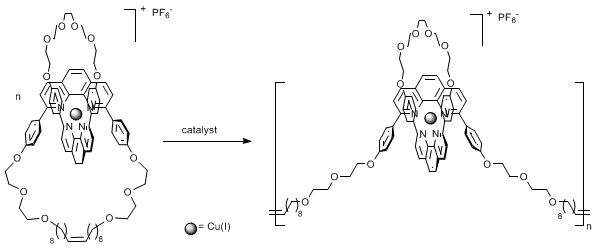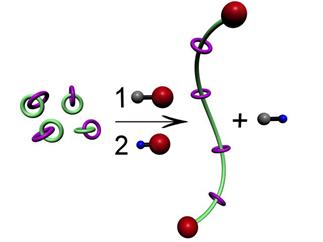
ACS PRF | ACS
All e-Annual Reports

42943-G1
Linear Oligocatenanes and Catenane Dendrimers: Synthesis and Determination of the Effect of Structural Concatenation on Polymer Properties
Our research has involved the development of a ring-opening metathesis polymerization (ROMP) of various macrocyclic olefins. Since the macrocycles are relatively unstrained, the ROMP reaction is presumably driven by an increase in entropy rather than a decrease in enthalpy. After some optimization of the ROMP reaction conditions and optimization of the macrocyclic monomer structure, we have been able to obtain polymers with a weight average molecular weight up to 53 kDa and a corresponding polydispersity index of 2.3, Scheme 1.
Scheme 1. ROMP of a macrocycle. Using a known copper(I) templated approach, we synthesized similar macrocyclic olefins that were mechanically interlocked with another macrocycle, i.e. [2]catenanes. In this case, only one of the two interlocked macrocycles contained an olefin. We subjected the olefinic [2]catenane to the developed conditions for macrocyclic ROMP and we were able to obtain oligomeric samples (polypseudorotaxanes) with a similar degree of polymerization, Scheme 2. Scheme 2. ROMP of an olefinic [2]catenane. At this point, the copper ions which hold the macrocycles to the acyclic oligomeric chain may be removed. However in the absence of such binding, significant attractive interactions between the macrocycles and the acyclic oligomeric chain are lacking and dissociation of the macrocycles from the acyclic oligomeric chain may occur. Two functional reagents are needed to produce an overall new synthetic methodology that allows extension of the above methodology to the synthesis of polyrotaxanes. One of these reagents consists of a custom olefin metathesis precatalyst that has been modified to include a bulky stopper group that is covalently attached to the initiating carbene ligand. After synthesis and testing of numerous versions of ruthenium-based olefin metathesis initiators that carry a sufficiently bulky group on the benzylidene ligand, we have at last discovered an initiator, Figure 1 (left), that provides acceptable levels of monomer conversion (>90%) for monomers as pictured in Schemes 1 and 2. The other necessary reagent required to access polyrotaxanes consists of a chain transfer agent that can be used to terminate the ROMP reaction and simultaneously deliver a bulky stopper group to the active (catalyst bound) end of the living polymer chain. We have synthesized the bulky chain transfer agent shown below for that purpose, Figure 1 (right). Figure 1. Olefin metathesis initiator (left) and chain transfer agent (right). With all needed components now in hand, we are currently optimizing the one pot synthesis of polyrotaxanes as schematically shown in Scheme 3. Scheme 3. One pot synthesis of a polyrotaxane. Step 1: Initiation of ROMP of olefinic [2]catenanes with the macroinitiator. Step 2: Termination using the bulky chain transfer agent. The results obtained thus far should be of general interest to those working in the field of supramolecular polymer chemistry and to those with an interest in mechanically interlocked polymers. The preliminary data generated with the funding from this grant has allowed us to obtain further funding under the Advanced Research Program (ARP) from the Texas Higher Education Coordinating Board (THECB). 


